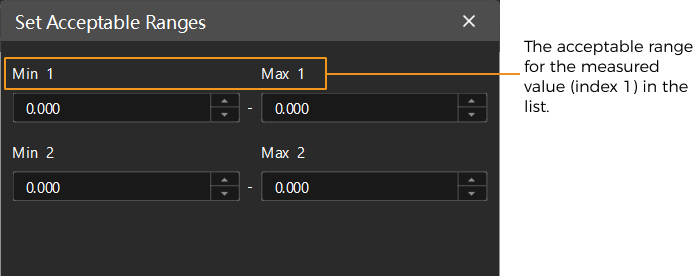Evaluate Values in List
Description
When the returned result of an output item is a list, use this Step to determine whether each measured value in the list is within the acceptable range and locate the NG values.
Basic Concepts
List and index
-
List
A list is a structured collection of data consisting of multiple measured values. Each measured value has a fixed position in the list.
-
Index
The index indicates the position of the measured value in a list, starting from 1 and increasing sequentially.

Input Description
The input of this Step should be zero-dimensional data. If the input data is not zero-dimensional, you can use the Extract Data Step to obtain the required zero-dimensional data.
Parameter Description
First, select the Evaluation Mode to determine how to evaluate whether each value in a list is within the respective valid range. You can choose Custom or Incremental:
-
In this case, set a valid range for each measured value in the list to determine whether each value is qualified (OK).
-
In this case, set the valid range for the first measured value (index 1), and the valid ranges for the remaining values in the list will increment on this basis to determine whether each value is qualified (OK).
Once an evaluation mode is selected, you can set the relevant parameters accordingly.
Custom
Set the following parameters when the “Evaluation Mode” is set to Custom.
| Parameter | Description | ||
|---|---|---|---|
Number of Measured Values |
The number of measured values in the list input into the Step.
|
||
Set Acceptable Ranges |
Set an individual valid range for each value in the list. Click Open the editor to set a Min and Max for each value in the list to determine their respective valid range. The maximum and minimum values are all marked by the index of the values in the list. 
|
Incremental
Set the following parameters when the “Evaluation Mode” is set to Incremental.
| Parameter | Description | ||
|---|---|---|---|
Number of Measured Values |
The number of measured values in the list input into the Step.
|
||
Min 1 |
The lower limit of the acceptable range for the first measured value (index 1) in the list. |
||
Max 1 |
The upper limit of the acceptable range for the first measured value (index 1) in the list. |
||
Increment |
Apply the increment to determine the acceptable ranges for subsequent values on the basis of the acceptable range of the first measured value. |
Output Description
Select the output item(s) to add the output port(s) to the Step, and the corresponding data will be output after the Step is run. You can select the output according to the actual measurement requirements.
|
If you select an expandable output item, you should expand it by clicking ▶, and then set the Min and Max values to determine the acceptable range. If the output value falls within the acceptable range, the measurement item is judged as passing (OK), or else it is judged as failing (NG). |
| Output item | Description |
|---|---|
List |
The list input into the Step. |
NG Count |
The number of measured values in the list judged as NG. |
OK Count |
The number of measured values in the list judged as OK. |
NG Index |
The indices of NG measured values in the list. |
NG Value |
The NG measured values in the list. |
Min NG Index |
The index of the minimum NG value. |
Min NG Value |
The minimum NG value. |
Max NG Index |
The index of the maximum NG value. |
Max NG Value |
The maximum NG value. |
Troubleshooting
|